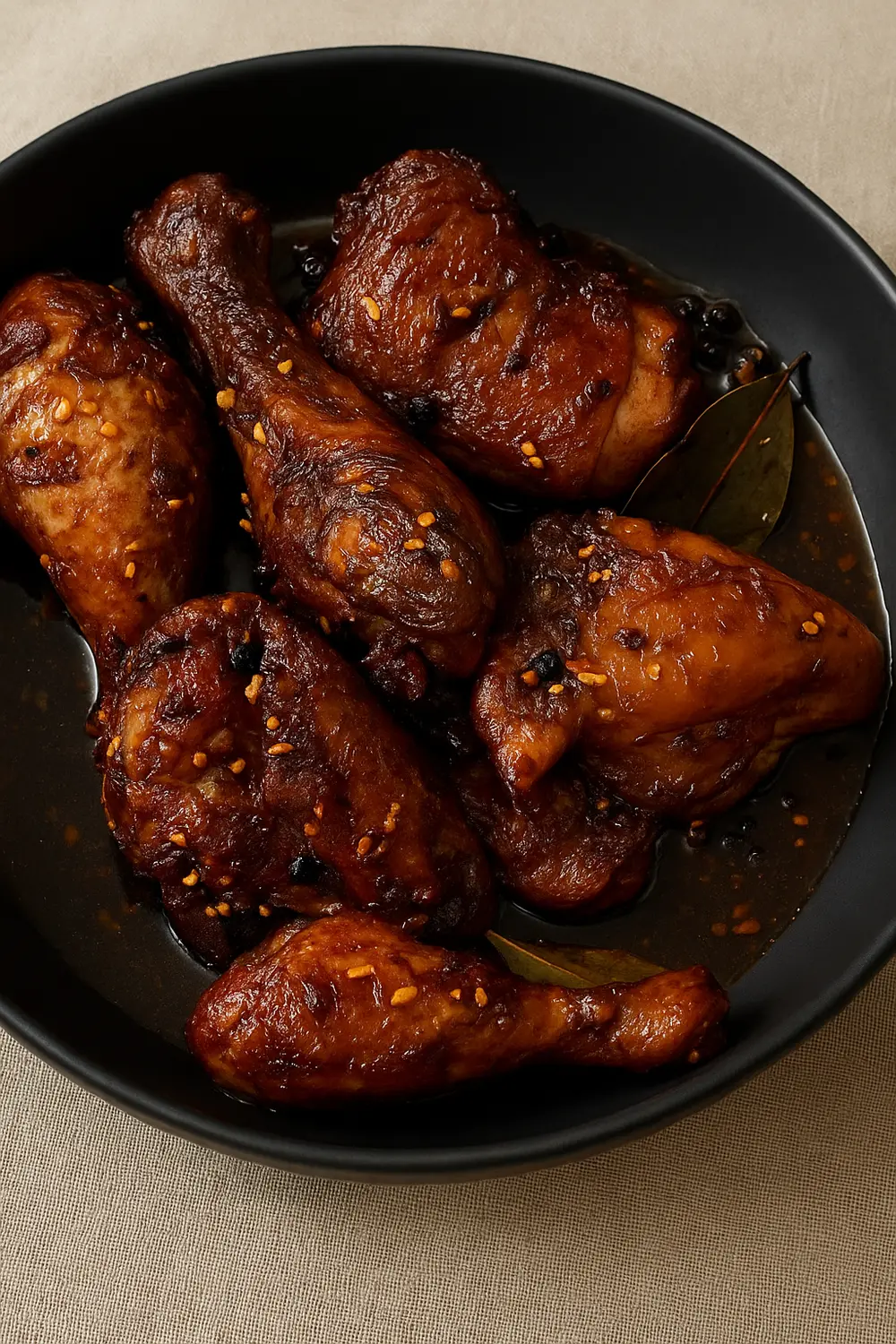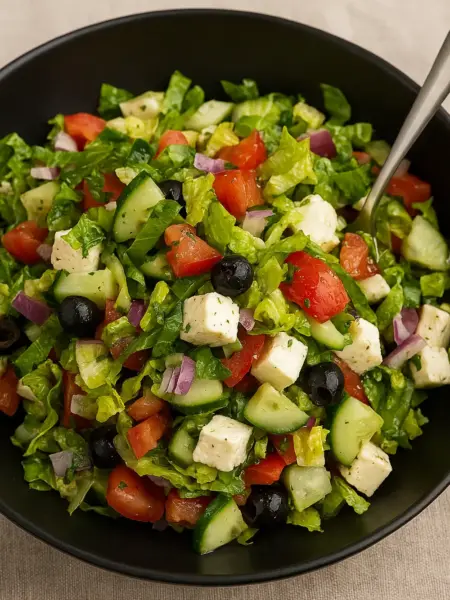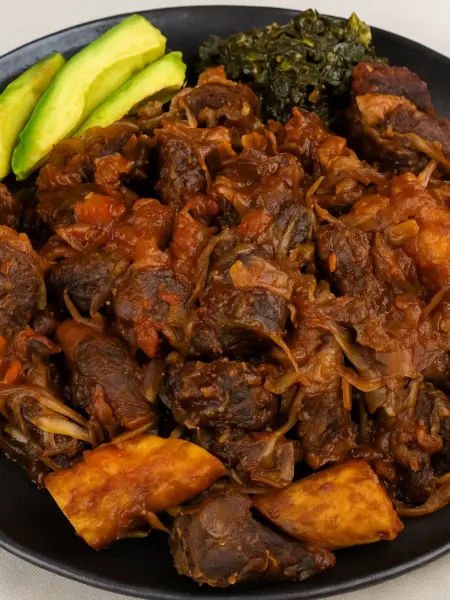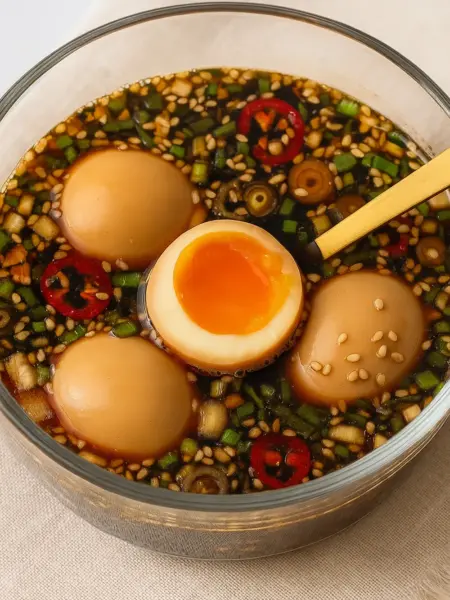This post may contain affiliate links, meaning I may earn a commission if you make a purchase, at no extra cost to you. I only recommend products I trust. Thank you for your support.
Filipino Chicken Adobo is one of the most beloved dishes in the Philippines, celebrated for its bold, savory, and tangy flavors that make every bite unforgettable.
The word “adobo” comes from the Spanish term for marinade, and although its roots trace back to colonial history, the dish has since evolved into a distinct and celebrated Filipino culinary tradition.
This Filipino chicken adobo recipe features tender chicken and soft potatoes simmered slowly in a garlicky blend of soy sauce, vinegar, and aromatic spices for a bold, savory flavor.
This chicken adobo Filipino recipe is easy to make, serves six, and is perfect for family dinners, Christmas dinners, meal prep, or sharing with friends.
You can pair adobo chicken with steamed white rice, garlic fried rice, sautéed vegetables, or a fresh side salad to balance the rich, savory flavors.
Adobo carries a sense of nostalgia and cultural pride, as many Filipinos grow up watching their parents or grandparents prepare it, with its aroma evoking memories of family gatherings and holiday celebrations.
✅ Read the entire article to ensure you’re fully prepared with all the necessary equipment and ingredients. The full recipe and cooking instructions are below.
Key Ingredients for This Filipino Chicken Adobo Recipe
The ingredients in this Filipino chicken adobo recipe create its signature savory, tangy, and aromatic flavor, with each component playing an essential role in building the rich, comforting sauce that makes this dish so beloved.
1. Chicken
- The star protein in this dish, chicken thighs or drumsticks offer a rich flavor and natural fattiness that keeps the meat juicy during slow simmering.
- Their bone‑in, skin‑on form helps lock in moisture and adds extra depth to the overall flavor profile.
2. Vinegar
- Vinegar provides the signature tangy acidity of adobo, which balances the savory elements.
- Traditional cane vinegar offers a mild, slightly sweet bite, but white or apple cider vinegar work well too.
3. Soy Sauce
- This ingredient contributes deep umami and a harmonious salty-sweet flavor. It forms the foundation of the adobo sauce, binding the other ingredients together.
4. Oyster Sauce
- A key enhancer in the sauce, oyster sauce delivers a rich, savory layer of flavor. Its slight sweetness and depth boost the overall umami, complementing both the chicken and the tangy vinegar.
5. Aromatics
- Aromatics such as garlic, bay leaves, and black peppercorns are crucial for building the complex flavor profile of adobo.
- Smashed garlic releases a robust aroma and taste; dried bay leaves add a subtle herbal note; and whole peppercorns contribute a gentle heat and earthiness that ties everything together.
6. Potatoes
- Adding white potato chunks not only gives the dish a hearty texture but also allows them to absorb the tangy and savory sauce, creating a comforting and satisfying bite.
7. Chipotle Peppers & Sugar
- For a modern twist, chipotle peppers in adobo sauce can introduce a smoky, mildly spicy note. A pinch of sugar may be added to balance the vinegar’s sharp tang, if desired.
8. Cooking Oil
- A neutral cooking oil (such as vegetable or canola oil) is essential for searing the chicken and toasting the aromatics. It helps develop a flavorful fond on the bottom of the pot, which becomes a key component of the adobo sauce.
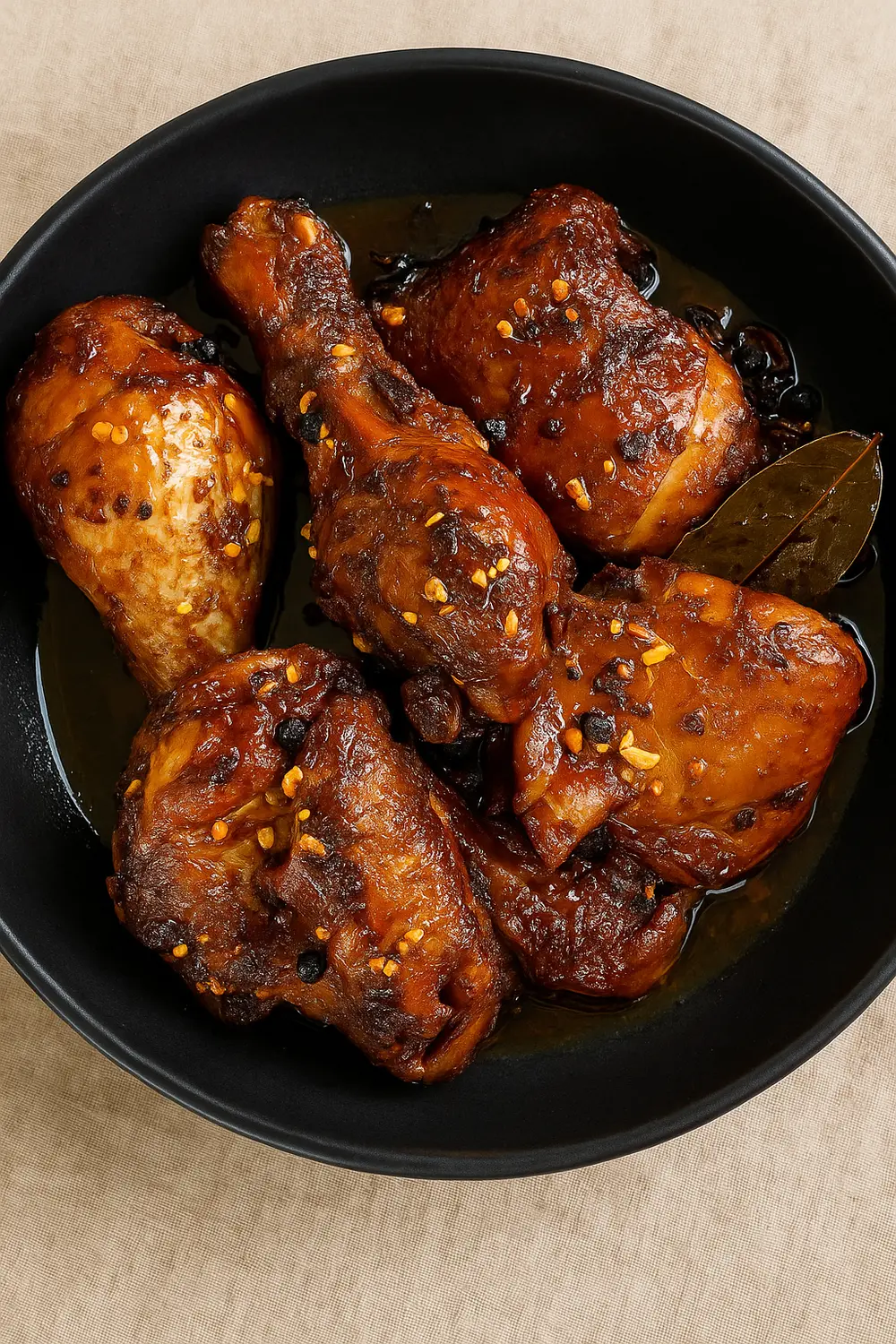
Essential Tools Needed for This Adobo Chicken Recipe
With just a few basic kitchen tools, you can easily prepare this classic dish, ensuring even cooking and perfect results every time.
- Dutch Oven or Heavy Bottomed Pot: This is ideal for achieving an even sear and ensuring a consistent, gentle simmer. Its heavy construction helps retain heat, crucial for the slow-cooking process.
- Large Bowl: For marinating the chicken. A bowl large enough to hold all pieces ensures even coating and flavor distribution.
- Sharp Knife and Cutting Board: Essential for prepping ingredients like garlic, potatoes, and any other vegetables. A good knife makes slicing and chopping quick and efficient.
- Wooden Spoon: Perfect for stirring, scraping the bottom of the pot, and ensuring that all the browned bits, which are flavor gold, are incorporated into the sauce.
- Tongs: Useful for transferring the chicken safely from the pot to the baking sheet, especially during the broiling step.
- Baking Sheet and Aluminum Foil: These are needed for the final broiling step to crisp up the chicken and finish off the dish with a beautiful caramelized exterior.
- Measuring Cups and Spoons: For accurate measurement of liquids and seasonings to ensure the right balance of flavors.
Nutritional Benefits of Chicken Adobo
Chicken adobo is a nutritional powerhouse, offering a variety of health benefits:
- High Protein Content: Packed with lean protein, chicken provides essential amino acids that help build and repair muscles, support metabolic function, and keep you feeling fuller for longer.
- Rich in Antioxidants: Garlic, one of the core aromatics in adobo, is rich in antioxidants and has natural immune-boosting properties; it may also contribute to improved heart health and lower blood pressure.
- Anti-Inflammatory Foods: Bay leaves contain anti-inflammatory compounds and aid digestion, making them a small but mighty ingredient.
- Low in Calories: Despite its robust flavor, adobo chicken is relatively low in calories, making it a satisfying yet healthy meal option.
- Regulate Blood Sugar: Vinegar, traditionally used in adobo, not only gives the dish its signature tang but also helps regulate blood sugar levels and supports gut health with its natural antimicrobial properties.
- Fiber-Rich: Potatoes are an excellent source of dietary fiber, which promotes healthy digestion and supports gut health by aiding regular bowel movements.
- Abundance of Essential Vitamins: Chicken, along with the aromatics in this dish, contributes important vitamins like B vitamins for energy metabolism and immune support, while other ingredients offer antioxidants that help maintain overall wellness.
- High Mineral Content: The combination of chicken and potatoes delivers a good source of essential minerals such as iron, potassium, and zinc, which play vital roles in maintaining healthy muscles, nerve function, and a robust immune system.
- Balanced Macros: With a good mix of protein, a moderate amount of fat, and carbohydrates from potatoes and any accompanying rice, this dish offers a balanced nutritional profile.
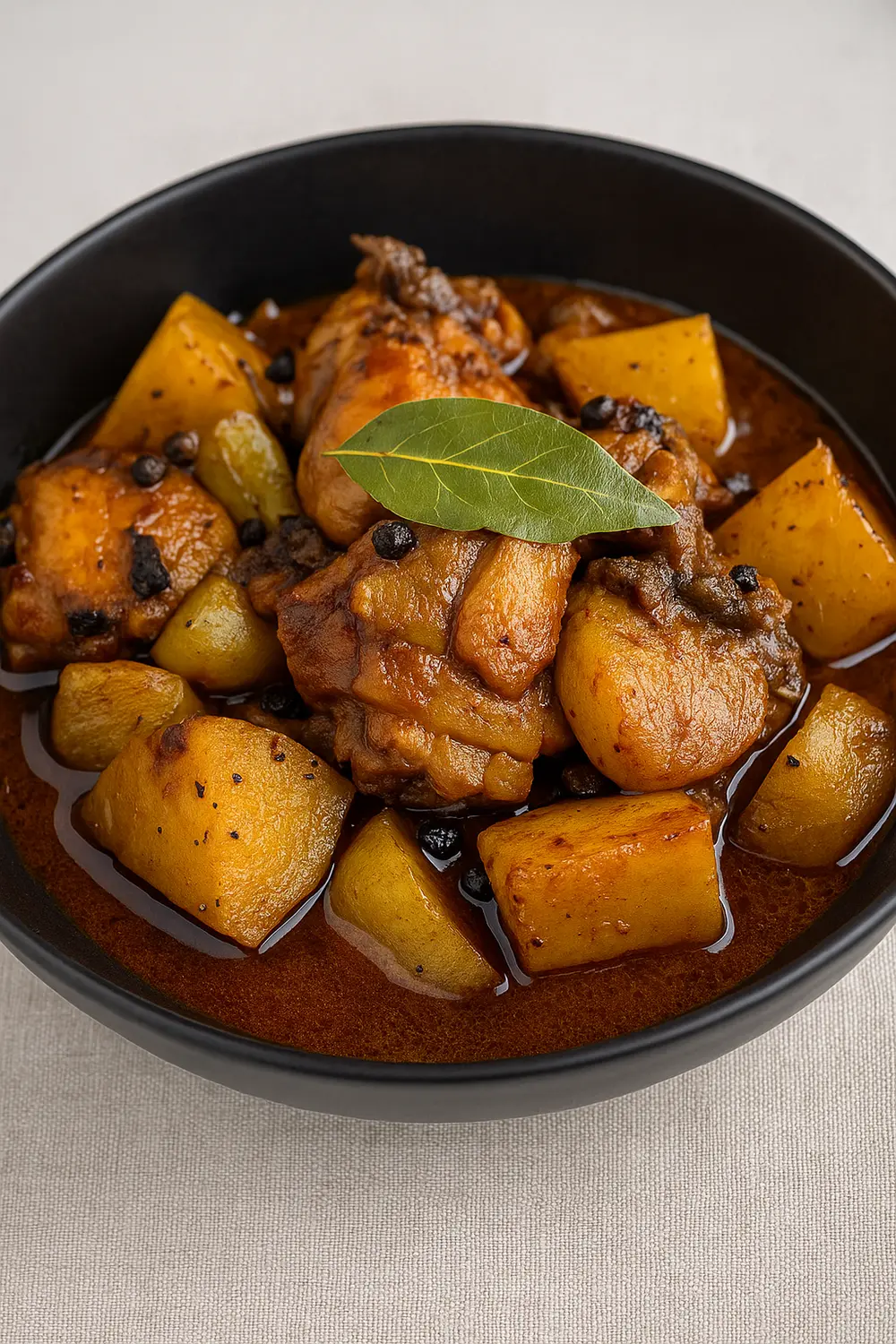
What to Serve or Pair With Adobo Chicken
For a truly authentic Filipino dining experience, serving chicken adobo with the right sides can elevate the dish and offer a complete meal that embraces the flavors and traditions of the Philippines.
1. Steamed White Rice
- The most traditional and essential side for chicken adobo is steamed white rice.
- The fluffy, neutral flavor of the rice pairs perfectly with the savory, tangy, and slightly salty adobo sauce, allowing the bold flavors of the chicken and marinade to shine.
2. Garlic Rice (Sinangag)
- This Filipino chicken adobo recipe is made by stir-frying leftover rice with garlic and a bit of oil.
- It’s aromatic, savory, and a perfect complement to the richness of adobo, making the meal even more satisfying.
3. Atchara (Pickled Papaya)
- For a sweet and tangy contrast, atchara, a Filipino pickled green papaya, is a great accompaniment.
- Its crisp texture and vibrant flavor balance out the richness of the chicken adobo, offering a refreshing and zesty bite that cuts through the dish’s savory profile.
4. Kangkong or Filipino-Style Sautéed Vegetables
- To add some green and nutritional balance to your meal, serve your chicken adobo with kangkong (water spinach) sautéed with garlic, onions, and a splash of fish sauce.
- This simple vegetable dish is a staple in Filipino cuisine and pairs wonderfully with the deep flavors of adobo.
- Alternatively, any sautéed leafy greens like malunggay (moringa) or talinum also make excellent choices.
5. Banana Chips or Fried Plantains
- If you’re looking to introduce a little sweetness into the meal, banana chips or fried plantains make an excellent pairing.
- The crispiness of the fried bananas complements the savory chicken, while the natural sweetness offers a pleasant contrast to the salty adobo.
6. Filipino Pancit (Noodles)
- A Filipino feast wouldn’t be complete without pancit, a dish of stir-fried noodles often served during celebrations.
- While not traditional with adobo, pancit canton adds a wonderful textural contrast and a burst of flavor to the meal.
7. Lemon or Calamansi
- For an extra touch of freshness, serve your adobo chicken with a wedge of lemon or calamansi, a small lime native to the Philippines.
- Squeezing a bit of fresh juice over the dish enhances the flavors, adding a touch of acidity that brightens the rich, savory sauce.
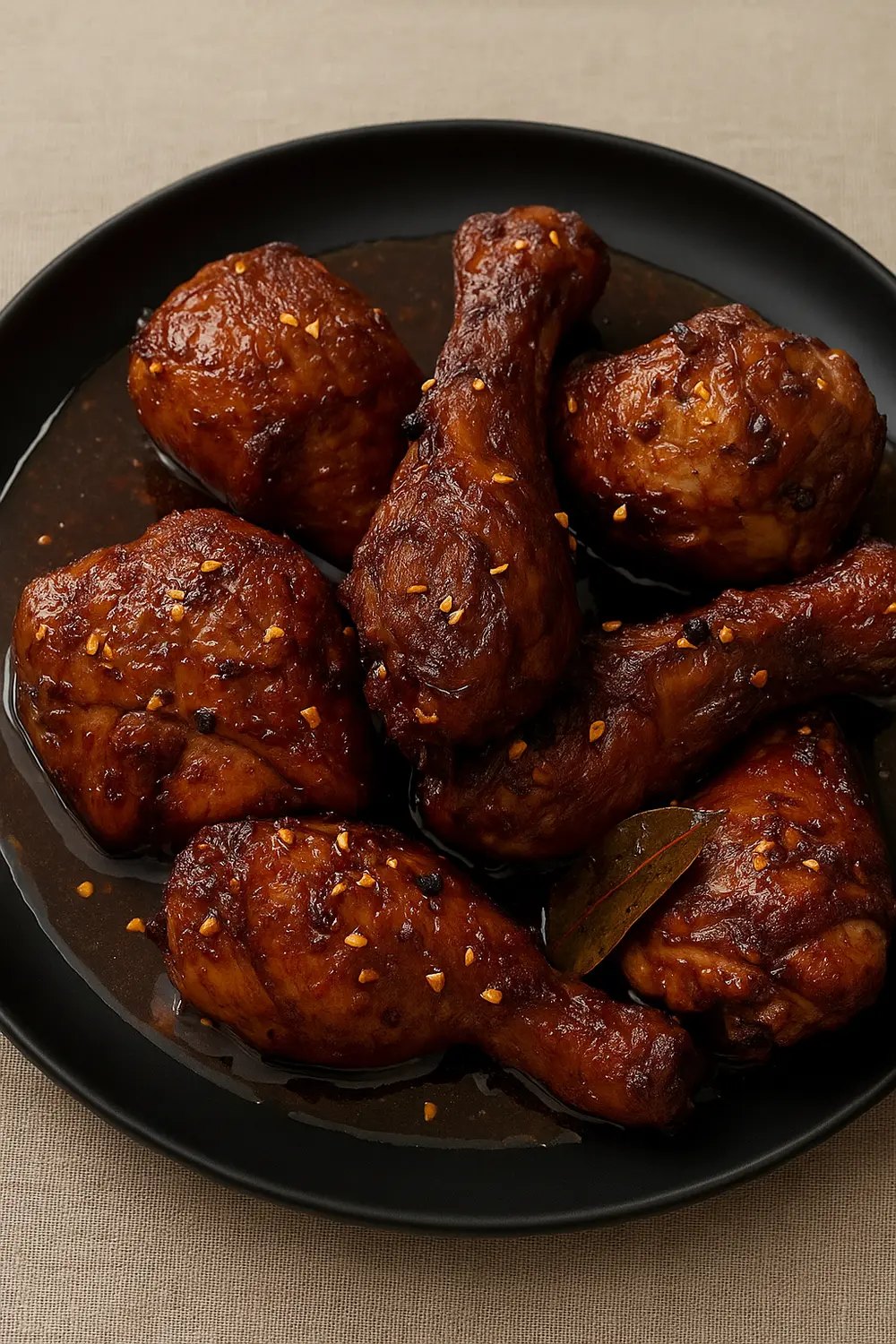
Tips for Making the Best Chicken Adobo
To make the best chicken adobo, focus on balancing the tangy and savory flavors, using fresh ingredients, and cooking the chicken slowly so it becomes tender and infused with the rich, garlicky sauce.
1. Use Bone-In, Skin-On Chicken
For maximum flavor and tenderness, use bone-in, skin-on chicken pieces, as the bones enrich the sauce and give it a deeper, more savory taste.
The skin helps lock in moisture, keeping the meat juicy and succulent, while thighs and drumsticks remain perfectly tender even after slow simmering in the adobo sauce.
2. Balance the Vinegar and Soy Sauce
The hallmark of chicken adobo is its tangy-salty sauce, so start with equal parts soy sauce and vinegar and adjust as you cook to achieve the perfect balance.
Some prefer a slightly tangier flavor while others like it saltier, making it important to taste the sauce as it simmers and tweak it to your liking.
3. Don’t Skip the Garlic
Garlic is essential for authentic chicken adobo flavor, and using fresh, finely minced garlic sautéed briefly before adding the chicken creates a fragrant base.
This simple step elevates the overall depth of the dish, infusing every bite with aromatic, savory notes.
4. Simmer the Chicken Slowly
Cook the chicken over low to medium heat so it can absorb all the flavors of the sauce thoroughly.
A gentle simmer prevents the meat from drying out and allows the sauce to thicken naturally into a rich, savory coating.
5. Add Potatoes or Hard-Boiled Eggs
Adding potatoes allows them to soak up the adobo sauce, making the dish heartier and more comforting.
Hard-boiled eggs are another great addition, bringing extra richness and texture that pairs beautifully with the savory chicken.
6. Include Aromatics for Depth
Bay leaves, black peppercorns, and a touch of onion add subtle layers of flavor that enhance the sauce without overpowering the chicken.
These simple aromatics create a more complex and well-rounded taste that makes the dish truly memorable.
7. Let It Rest for Maximum Flavor
Adobo tastes even better the next day. Allowing the dish to rest in the refrigerator overnight lets the flavors meld, resulting in a richer, more savory sauce.
8. Caramelize the Sauce
Simmering the sauce a little longer until it reduces and caramelizes adds a slightly sweeter, deeper flavor, giving the chicken adobo a glossy, rich finish that looks as good as it tastes.
Final Remarks
This Filipino chicken adobo recipe is a perfect balance of savory, tangy, and garlicky flavors, with tender chicken and soft potatoes simmered to perfection in a rich, aromatic sauce.
Feel free to customize it by adding hard-boiled eggs, extra potatoes, or even a touch of coconut milk for a creamier twist, or adjust the soy-vinegar ratio to suit your taste.
Pair it with steamed white rice, garlic fried rice, or sautéed vegetables for a complete meal that’s comforting and satisfying for any occasion.
If you give this adobo chicken recipe a try, we’d love to hear how it turned out, share your version, or drop your thoughts in the comments.
You’ll find the complete list of ingredients and step-by-step cooking instructions just below.
Authentic Filipino Chicken Adobo Recipe
This easy Filipino chicken adobo recipe serves six and features tender chicken and soft potatoes simmered in a garlicky blend of soy sauce, vinegar, and aromatic spices for a bold and authentic Filipino flavor.
Ingredients
For Chicken and Marinade
For Vegetables and Additional Flavors
Optional Garnishes
How to Make Chicken Adobo (Step-By-Step Instructions)
Prep and Sear the Chicken
Prepare the Ingredients
- Smash and peel the garlic cloves.
- Pat dry the chicken thighs, drumsticks, or a mix of both using paper towels.
- Season the chicken evenly with kosher salt.
Sear the Chicken
- Heat 1 tablespoon of neutral oil (like vegetable or canola oil) in a Dutch oven or large, heavy-bottomed pot over medium-high heat until the oil shimmers.
- Working in two batches, add the chicken pieces (place skin-side down for thighs) to the pot.
- Sear each batch until the chicken is browned on all sides, about 6 minutes per batch.
- Adjust the heat as needed to prevent burning.
- Once browned, transfer the chicken to a plate.
Create the Adobo Sauce
Toast the Aromatics
- In the same pot with the remaining oil and flavorful bits, add the smashed garlic cloves, dried bay leaves, chopped chipotle peppers, and black peppercorns.
- Stir continuously for 30 seconds to 1 minute until the garlic and peppercorns release their fragrance and become slightly toasted.
Build the Sauce
- Pour in 2 cups of water or chicken broth, soy sauce, cane vinegar, and oyster sauce.
- Use a wooden spoon to scrape up any browned bits stuck to the bottom of the pot.
- These bits add a rich depth to your sauce.
- Gently add the potato chunks to the pot; these will absorb the tangy sauce and provide a comforting texture.
Add Potatoes and Simmer the Chicken
- Return the seared chicken along with any accumulated juices back into the pot, arranging the pieces in a single layer (with skin-side down if applicable).
- Bring the mixture to a boil, then reduce the heat to maintain a gentle simmer.
- Let everything simmer for about 35–45 minutes, or until the chicken is tender and the potatoes have softened, but still hold their shape.
- Ensure that the thickest part of the chicken reaches at least 165ºF before moving on.
- Taste the sauce and adjust seasoning as needed; add a pinch of sugar if you prefer a slightly sweeter balance.
Broil for a Final Browning
Preheat the Broiler
- As the chicken nears doneness, set an oven rack in the upper third of your oven and preheat it to the broil setting.
- Line a rimmed baking sheet with aluminum foil for easy cleanup.
Broil the Chicken
- Using tongs, carefully transfer the chicken (placing it skin-side up if using thighs) onto the prepared baking sheet.
- Let the chicken continue to simmer on the stovetop with the sauce.
- Broil the chicken for about 3 minutes, or until the top is nicely browned.
- Remove the chicken, flip each piece, and brush with some of the hot adobo sauce.
- Return the chicken to the oven and broil for another 3 minutes until the second side is browned.
- Discard the bay leaves if desired before serving.
Serve and Garnish
Plate the Dish
- Spoon a generous portion of steamed white rice onto each plate for a true taste of Filipino cuisine.
- Top with one or two pieces of the broiled adobo chicken.
Drench in Sauce
- Finally, drizzle the rich adobo sauce generously over both the chicken and rice, allowing every bite to be infused with flavor.
- Garnish with freshly chopped green onions and cilantro if using, and add a squeeze of lime for a citrusy finish that brightens the dish.
Nutrition Facts
Servings 6
Serving Size 1 plate
- Amount Per Serving
- Calories 320kcal
- % Daily Value *
- Total Fat 15g24%
- Saturated Fat 4g20%
- Cholesterol 95mg32%
- Sodium 950mg40%
- Potassium 680mg20%
- Total Carbohydrate 22g8%
- Dietary Fiber 3g12%
- Sugars 4g
- Protein 35g70%
- Vitamin A 750 IU
- Vitamin C 12 mg
- Calcium 60 mg
- Iron 2.5 mg
- Vitamin D 80 IU
- Vitamin K 15 mcg
* Percent Daily Values are based on a 2,000 calorie diet. Your daily value may be higher or lower depending on your calorie needs.
Note
- Sear the chicken in batches to avoid overcrowding, which can cause steaming instead of browning.
- Maintain medium high heat when searing and adjust if needed to prevent burning.
- Preheat the broiler and line your baking sheet with foil to catch drips and ease cleanup.
- Evenly coat the chicken with kosher salt to enhance flavor and promote browning.
- Monitor the internal temperature; the chicken should reach at least 165°F for safe consumption.



